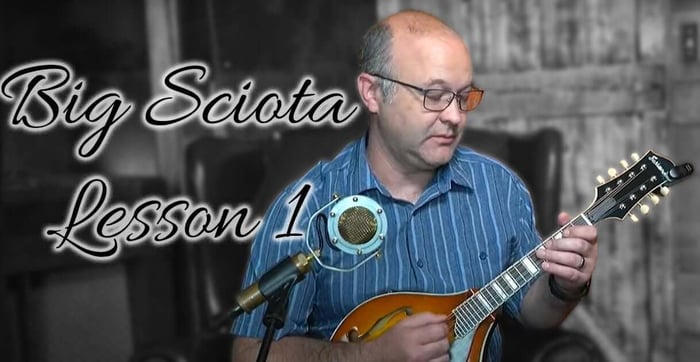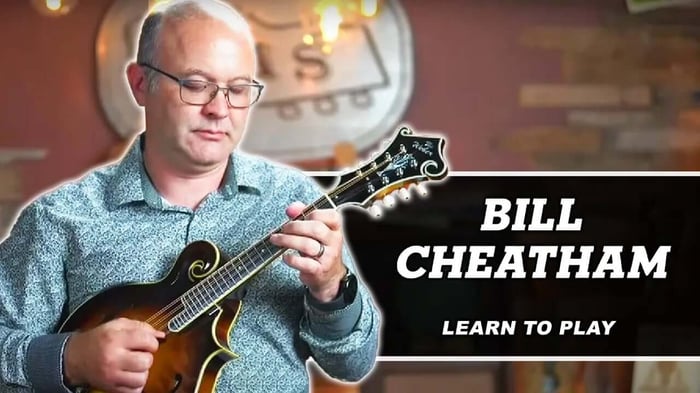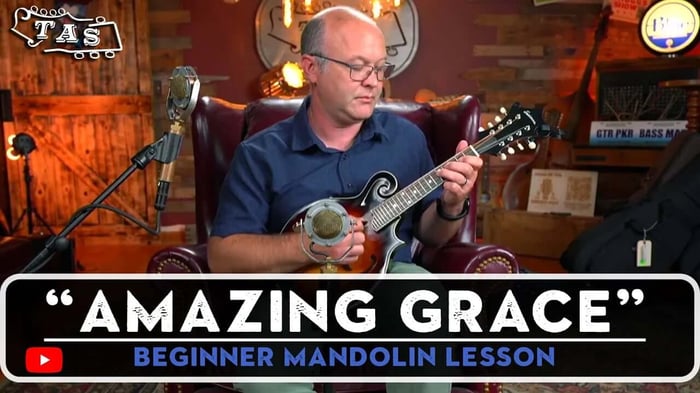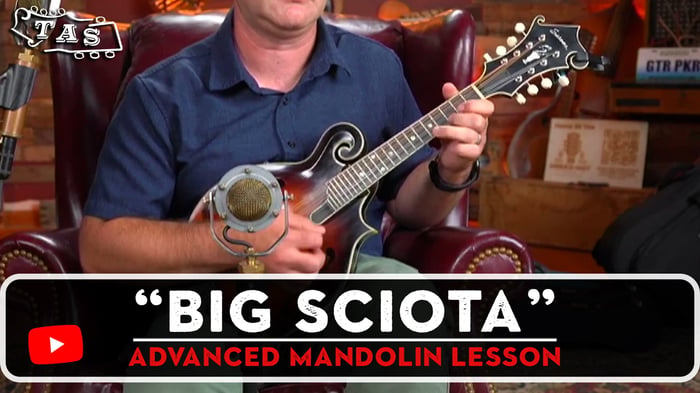Your Free Lesson: Big Sciota
Welcome to another exciting edition of Acoustic Shoppe Mandolin Sessions! This week, Jeremy Chapman is bringing you a beloved fiddle tune that’s sure to get your fingers moving: "Big Sciota." This is a fantastic tune for players looking to expand their repertoire with a classic, and in this lesson, we're focusing on an easier, melody-focused arrangement in the key of G. Whether you’re just starting out or looking to refine your technique, Jeremy breaks down the tune step-by-step, making it accessible for everyone.
This particular arrangement is perfect for getting comfortable with the melody, navigating chord changes in the key of G (G, C, D, and a fun E minor twist in the B part!), and introducing some fun mandolin techniques like slides. So grab your mandolin, settle in, and let's dive into "Big Sciota" Solo 1!
The Enduring Legacy of "Big Sciota": A Fiddle Tune with Deep Roots
"Big Sciota," often spelled "Big Scioty," is a cornerstone of American traditional music, particularly prevalent in the Appalachian old-time and bluegrass traditions. Like many tunes of its kind, its exact origins are somewhat shrouded in the mists of time, but its enduring popularity speaks volumes about its melodic charm and infectious rhythm.
The "Sciota" in the title almost certainly refers to the Scioto River, a major tributary of the Ohio River that flows through central and southern Ohio. This geographical reference suggests the tune likely originated or gained significant traction in the Ohio Valley region, a hotbed of fiddle music and cultural exchange during the 19th and early 20th centuries.
While no single composer is typically credited, "Big Sciota" embodies the communal and evolutionary nature of traditional music. Tunes were often learned by ear, passed down through generations, and adapted by individual musicians. Each player might add their own subtle variations, leading to multiple versions coexisting. This fluidity is a hallmark of folk music and contributes to its rich tapestry.
Historically, "Big Sciota" would have been a staple at square dances, community gatherings, and informal jam sessions. Its upbeat tempo and clear, memorable melody made it ideal for dancing. Fiddlers would have led the charge, with banjos, guitars, and mandolins providing rhythmic and melodic accompaniment. The tune's structure—typically an AABB form, with two distinct parts repeated—is characteristic of many old-time fiddle tunes, providing both familiarity and opportunities for improvisation.
Over the decades, "Big Sciota" has been recorded and performed by countless influential musicians across various genres, solidifying its place in the American folk canon. While its popularity surged with the rise of bluegrass music, it maintains a strong presence in the old-time revival scene, cherished for its authenticity and connection to a bygone era. Modern interpretations continue to bring new life to this classic, ensuring its legacy continues for future generations of acoustic musicians. It remains a testament to the power of simple, well-crafted melodies to transcend time and connect people through shared musical heritage.
References/Sources: General traditional music folklore, regional music histories of Appalachia and the Ohio Valley.
Key Takeaways from This Lesson: Unlocking "Big Sciota" on Mandolin
Jeremy's lesson on "Big Sciota" offers several valuable insights and techniques to help you master this tune:
Key of G Fundamentals: The lesson firmly establishes the tune in the key of G, emphasizing the primary G, D, and C chords, and introducing the E minor for the "B" part.
Pickup Notes Mastery: Jeremy clearly demonstrates how to correctly play the pickup notes on the fourth beat, crucial for starting the tune with proper timing.
Alternate Picking Emphasis: The importance of consistent down-up alternate picking for eighth notes is highlighted, ensuring rhythmic precision and fluidity.
Understanding Repeat Signs & Endings: Learn to navigate the first and second endings (brackets with "1st" and "2nd") and repeat signs (double dots) within the TAB, which are common in fiddle tunes.
The E Minor Twist: The B part's shift to an E minor chord provides a unique melodic and harmonic interest, a fun twist for a G-major tune.
Mandolin Slides: Jeremy introduces and thoroughly explains the technique of sliding into notes, specifically the 5-7 slide on the A string, a fundamental mandolin embellishment.
Chop Chord Foundations: For those looking to play rhythm, Jeremy quickly reviews the G, D, C, and E minor chop chord shapes, offering both two-finger and three-finger options.
Practice with Chords: The lesson encourages practicing the melody over a mandolin chord accompaniment, a great way to develop your sense of timing and improvisation.
Mandolin TAB/Chord Chart for "Big Sciota"
To help you follow along and solidify your learning, we've prepared a detailed TAB for this beginner-friendly arrangement of "Big Sciota." This TAB maps out the melody, fingerings, and rhythmic notation Jeremy teaches in the video.
[Download a high-quality PDF version of the TAB here!]
Note: While this TAB provides a clear guide, remember that traditional music is often learned by ear. Use the TAB as a tool, but also strive to internalize the melody and feel of the tune as you practice!
Listen to others play Big Sciota on our Spotify Playlist.
Practice Tips for Success with "Big Sciota"
Learning a new tune, especially one with a lively feel like "Big Sciota," thrives on smart practice. Here are some tips to help you master this week's lesson:
Start Slow, Stay Steady: Always begin practicing at a very slow tempo. Use a metronome from the outset, setting it to a comfortable pace where you can play every note cleanly and accurately. Gradually increase the tempo only when you're consistently hitting all the notes.
Focus on Pickup Notes: Pay special attention to the pickup notes before the first full measure. Jeremy emphasizes these, and getting them right sets the stage for the entire tune. Practice them in isolation until they feel natural.
Master the Slides: The 5-7 slide in the B part is a key technique. Practice this motion repeatedly, focusing on a smooth, clean slide that lands precisely on the seventh fret. Experiment with how much pressure you need.
Isolate Sections: If a particular measure or phrase is giving you trouble (e.g., the E minor section of the B part), isolate just those few notes. Practice them repeatedly until they're smooth, then slowly reintroduce them into the full tune.
Understand the Form: Get familiar with the AABB structure and how the first and second endings work. This helps you navigate the tune without getting lost and makes practicing repeats much easier.
Alternate Picking Consistency: Maintain strict alternate picking (down-up-down-up) throughout the tune. This builds efficiency and speed, crucial for playing fiddle tunes.
Practice with the Chords: After you've got the melody down, try playing the tune with a chordal accompaniment (either by a friend or a backing track). This helps you internalize the relationship and develop your rhythm.
Listen Actively: Listen to various recordings of "Big Sciota" by different mandolin players and fiddlers. This will help you get a feel for the tune, its nuances, and common variations, deepening your understanding beyond just the notes.
Gear Used in This Lesson
Jeremy uses some fantastic acoustic music gear from The Acoustic Shoppe.. Here's what he featured in this week's "Big Sciota" lesson:
Eastman MD605-GB Mandolin (Goldburst): This is Jeremy's go-to mandolin for many of his lessons. The MD-605 is a professional-grade A-style mandolin known for its excellent tone, playability, and beautiful sunburst finish. It comes equipped with a finger rest and a pickup, making it versatile for both practice and performance.
Tone Slab Pick (Jeremy Chapman Signature Model): Jeremy's personal choice, this 1.3mm pick offers a comfortable grip and helps produce a clear, articulate tone. A good pick makes a huge difference in your sound!
Peterson StroboClip HD Tuner: For absolute tuning precision, Jeremy relies on the Peterson StroboClip HD. This highly accurate strobe tuner ensures your mandolin is perfectly in tune, which is essential for good tone and intonation. [Link to your Peterson Tuner product page]
Tone-Gard: This innovative accessory attaches to the back of your mandolin, keeping it off your body. This allows the back of the instrument to resonate more freely, increasing volume and clarity, especially beneficial for new players seeking more projection when standing or in a jam session. [Link to your Tone-Gard product page]
Continue Your Journey with Free Mandolin Lessons!
We're passionate about helping you grow as a mandolin player. "Big Sciota" is just one of many amazing tunes and techniques you can learn with us. Explore more free mandolin lessons and dive deeper into the world of acoustic music!
Ready for another classic fiddle tune? Learn to play Bill Cheatham.
Find all of our other free mandolin lessons here at The Acoustic Shoppe Mandolin Sessions.
About Your Instructor: Jeremy Chapman
Your mandolin journey at The Acoustic Shoppe is guided by Jeremy Chapman, a musician who truly lives and breathes acoustic music. Jeremy spent over 25 years touring and performing with his family's bluegrass band, The Chapmans, even gracing the iconic stage of the Grand Ole Opry. With two decades of experience teaching private mandolin lessons, he's helped countless students find their way around the fretboard. Jeremy is also the author of the popular Do-It-Yourself Mandolin book (Hal Leonard), known for making learning accessible and fun. As President and CEO of The Acoustic Shoppe, he's dedicated to bringing the joy of music to players everywhere.






